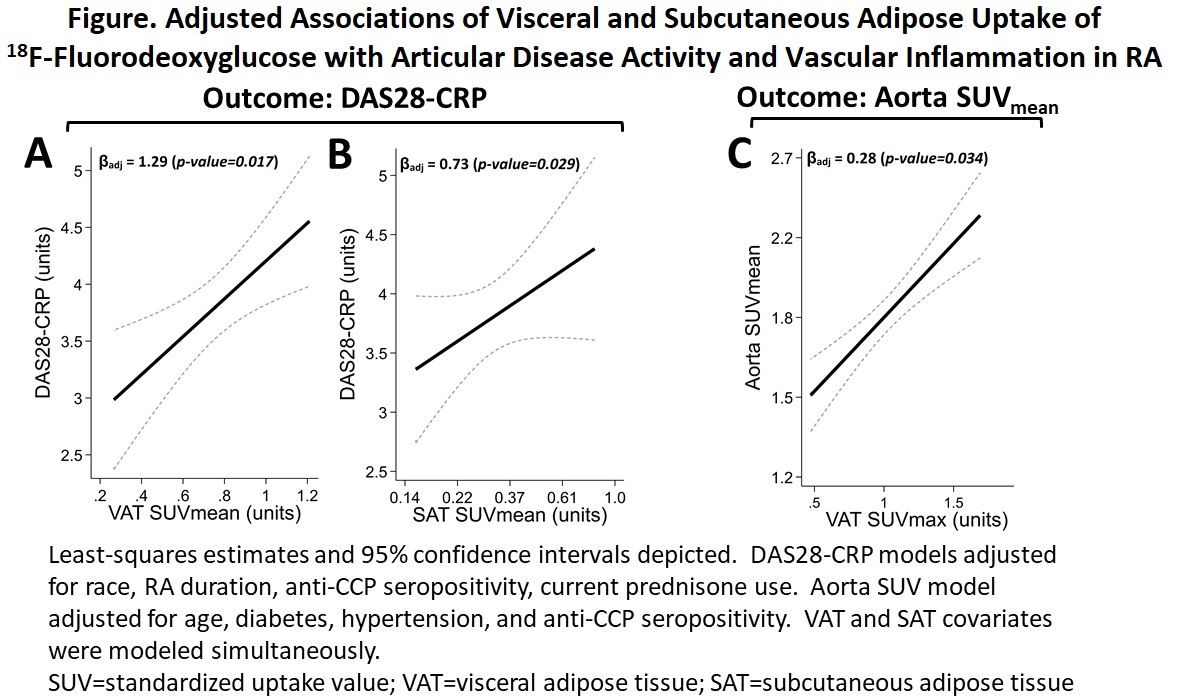Session Information
Session Type: Poster Session D
Session Time: 8:30AM-10:30AM
Background/Purpose: Subcutaneous adipose tissue (SAT) from people with RA contains more macrophages and expresses higher levels of cytokines, chemokines, and other inflammatory mediators compared with otherwise similar people without RA. Visceral adipose tissue (VAT), located within the thorax and surrounding mesenteric organs, tends to be more inflammatory than SAT and is more strongly associated with cardiometabolic outcomes, such as insulin resistance and atherosclerotic cardiovascular disease (CVD). However, due to its inaccessibility, little is known about the immunophenotype of VAT in RA and whether adipose inflammation is associated with other RA-specific features.
Methods: RA patients participating in a cohort study of CVD in RA underwent total body 18F-fluorodeoxyglucose positron emission tomography/computed tomography (FDG PET/CT). VAT and SAT regions were manually traced and the mean and maximal standardized uptake values (SUVmean and SUVmax) for FDG uptake were calculated for each adipose depot. Abdominal VAT and SAT volumes were measured at the L2/3 interspace. Mean and maximal uptake of FDG in the arterial wall of the ascending aorta was measured and reported for the entire vessel (SUVmean) and for the most diseased segment (SUVMDS). Generalized linear models were used to explore the associations of VAT and SAT volumes and SUV measures with RA features and aortic SUV.
Results: VAT and SAT FDG uptake was analyzed in 47 RA patients (81% women; mean age 55 years; median BMI=27.6 kg/m2; median RA duration=6.7 years; mean DAS28-CRP=3.80; current methotrexate, biologics, and prednisone in 49%, 36%, and 32%, respectively). Average SUVmean and SUVmax were higher in VAT than SAT [(SUVmean: 0.76 vs. 0.34 SUV units, respectively; p< 0.001) (SUVmax: 1.02 vs. 0.52 units, respectively; p< 0.001). Both VAT and SAT SUVmean were significantly and independently associated with DAS28-CRP, even after adjusting for pertinent confounders (Fig A & B). This association was driven by associations with swollen and tender joint counts, but not with CRP. VAT and SAT SUVmean accounted for 20% of the explainable variability in DAS28-CRP (Model total R2=0.58). Body mass index, VAT volume, and SAT volume were not associated with DAS28-CRP when comodeled with VAT and SAT SUVmean. VAT SUVmax was significantly associated with all measures of aorta SUV (shown for Aorta SUVmean in Fig C), even after confounder adjustment. SAT SUV was not associated with Aorta SUV.
Conclusion: Both visceral and subcutaneous adipose uptake of 18F-FDG, representing increased metabolic activity and/or adipose inflammation, was highly associated with articular disease activity and aortic FDG uptake, representing atherosclerotic plaque inflammation. These findings suggest that adipose inflammation could be a contributor to articular and vascular inflammation in RA, and potentially a target for intervention.
To cite this abstract in AMA style:
Giles J, Bathon J, Zureigat H, Tawakol A. Positron Emission Tomography-Detected Uptake of 18F-Fluorodeoxyglucose in Visceral and Subcutaneous Adipose Tissue Is Associated with Articular Disease Activity and Arterial Inflammation in Rheumatoid Arthritis [abstract]. Arthritis Rheumatol. 2021; 73 (suppl 9). https://acrabstracts.org/abstract/positron-emission-tomography-detected-uptake-of-18f-fluorodeoxyglucose-in-visceral-and-subcutaneous-adipose-tissue-is-associated-with-articular-disease-activity-and-arterial-inflammation-in-rheumatoid/. Accessed .« Back to ACR Convergence 2021
ACR Meeting Abstracts - https://acrabstracts.org/abstract/positron-emission-tomography-detected-uptake-of-18f-fluorodeoxyglucose-in-visceral-and-subcutaneous-adipose-tissue-is-associated-with-articular-disease-activity-and-arterial-inflammation-in-rheumatoid/

